HTH_ARSRhelix_turn_helix, Arsenical Resistance Operon Repressor |
|---|
| SMART accession number: | SM00418 |
|---|---|
| Description: | - |
| Interpro abstract (IPR001845): | The arsR-type HTH domain is a DNA-binding, winged helix-turn-helix (wHTH) domain present in transcription regulators of the arsR/smtB family, involved in stress-response to heavy metal ions. This family of prokaryotic metal-sensing transcription repressors is named after Escherichia coli arsR, an arsenic-responsive repressor of the ars operon for arsenate reductase and metal ion extrusion, and after Synechococcus PCC 7942 smtB, a Zn(II)-responsive repressor of the smtA gene for a Zn sequestering metallothionein [ (PUBMED:12829264) ]. ArsR/smtB-like repressors of metal resistance operons specifically bind to the operator/promoter and seem to dissociate from the DNA in the presence of metal ions, permitting transcription of proteins involved in metal-ions efflux and/or detoxification. The crystal structure of the cyanobacterial smtB shows a fold of five alpha-helices (H) and a pair of antiparallel beta-strands (B) in the topology H1-H2-H3-H4-B1-B2-H5. Helices 3 and 4 comprise the helix-turn-helix motif and the beta-sheet is called the wing as in other wHTH, such as the dtxR-type or the merR-type. Helix 4 is termed the recognition helix, like in other HTHs where it binds the DNA major groove. Most arsR/smtB-like metalloregulators form homodimers [ (PUBMED:14568530) ]. The dimer interface is formed by helix 5 and an N-terminal part [ (PUBMED:9466913) ]. Two distinct metal-binding sites have been identified. The first site comprises cysteine thiolates located in the HTH in helix 3 and for some cases in the N terminus, called the alpha3(N) site [ (PUBMED:12829264) (PUBMED:14568530) (PUBMED:8506147) ]. The second metal-binding site is located in helix 5 (and C terminus) and is called the alpha5(C) site. The alpha3N site binds large thiophilic, toxic metals including Cd, Pb, and Bi, as in S. aureus cadC. ArsR lacks the N-terminal arm and its alpha3 site coordinates smaller thiophilic ions like As and Sb. The alpha5 site contains carboxylate and imidazole ligands and interacts preferentially with biologically required metal ions including Zn, Co, and Ni. ArsR-type metalloregulators contain one of these sites, both, or other potential metal-binding sites [ (PUBMED:12829264) (PUBMED:14960585) ]. Binding of metal ions to these sites leads to allosteric changes that can derepress the operator/promoter DNA. The metal-inducible operons contain one or two imperfect 12-2-12 inverted repeats, which can be recognised by multimeric arsR-type metalloregulators. Some proteins known to contain an arsR-type HTH domain:
|
| GO process: | regulation of transcription, DNA-templated (GO:0006355) |
| GO function: | DNA-binding transcription factor activity (GO:0003700) |
| Family alignment: |
There are 120969 HTH_ARSR domains in 120802 proteins in SMART's nrdb database.
Click on the following links for more information.
- Evolution (species in which this domain is found)
- Literature (relevant references for this domain)
- Metabolism (metabolic pathways involving proteins which contain this domain)
- Structure (3D structures containing this domain)
- Links (links to other resources describing this domain)













































